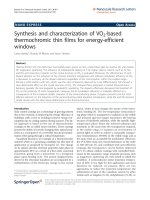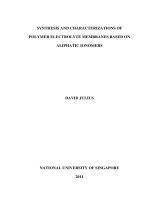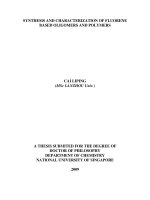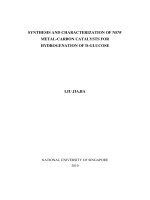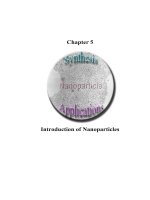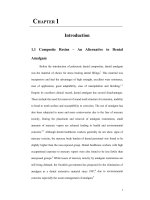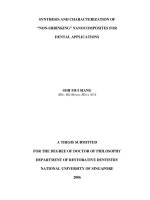Synthesis and characterization of superhydrophilic self-cleaning film based on TiO2/SiO2 composite for photovoltaic applications
Bạn đang xem bản rút gọn của tài liệu. Xem và tải ngay bản đầy đủ của tài liệu tại đây (816.68 KB, 7 trang )
TNU Journal of Science and Technology
227(15): 110 - 116
SYNTHESIS AND CHARACTERIZATION OF SUPERHYDROPHILIC
SELF-CLEANING FILM BASED ON TiO2/SiO2 COMPOSITE FOR
PHOTOVOLTAIC APPLICATIONS
Luu Tuan Anh1,2*, Tran Hoang Thao Nhi1,2, Nguyen Thi My Anh1,2
1
Ho Chi Minh City University of Technology, 2Vietnam National University Ho Chi Minh City
ARTICLE INFO
Received:
17/9/2022
Revised:
22/11/2022
Published:
22/11/2022
KEYWORDS
Superhydrophilic
Self-cleaning
Photocatalytic
Sol-gel method
Photovoltaic panel
ABSTRACT
Transparent, superhydrophilic materials in photovoltaic (PV)
applications are indispensable for their self-cleaning function, which
can protect the solar cell and raise the efficiency of solar modules. This
study presented the synthesis and fabrication of TiO2/SiO2 films by the
dip-coating method of sol−gel solutions on glass. The TiO2/SiO2
composites containing different SiO2 contents were characterized by
XRD and FTIR. The transparency and hydrophilic properties of the
films were investigated by UV-vis and WCA. TiO2 sol was mixed with
SiO2 sol by differing TiO2/SiO2 ratios of 1/3, 1/1, and 3/1. The best
TiO2/SiO2 coating with the ratio of 1/3 was attained on the glass
surface after calcining the template at 400 °C. The maximum
transmittance of this film reached ∼93.0%, and the film surface showed
an excellent super-hydrophilicity with WCA ≈ 4.7°. The results
revealed that this composite material would be a promising candidate
for the self-cleaning applications of solar module surfaces.
TỔNG HỢP VÀ ĐÁNH GIÁ MÀNG VẬT LIỆU TiO2/SiO2 TỰ LÀM SẠCH,
SIÊU THẤM NƯỚC ỨNG DỤNG TRONG LĨNH VỰC ĐIỆN MẶT TRỜI
Lưu Tuấn Anh1,2*, Trần Hoàng Thảo Nhi1,2, Nguyễn Thị Mỹ Anh1,2
1
Trường Đại học Bách khoa Thành phố Hồ Chí Minh, 2Đại học Quốc gia Thành phố Hồ Chí Minh
THƠNG TIN BÀI BÁO
Ngày nhận bài:
17/9/2022
Ngày hoàn thiện: 22/11/2022
Ngày đăng: 22/11/2022
TỪ KHÓA
Siêu ưa nước
Tự làm sạch
Xúc tác quang
Phương pháp sol-gel
Pin mặt trời
TĨM TẮT
Việc nghiên cứu vật liệu có độ truyền qua cao và có tính siêu ưa nước
ứng dụng cho lĩnh vực điện mặt trời là nhằm mục đích bảo vệ bề mặt
của tấm pin, duy trì hiệu suất quang điện và giảm chi phí bảo dưỡng cho
hệ thống. Bài báo này trình bày quá trình tổng hợp vật liệu kết hợp
TiO2/SiO2 bằng phương pháp sol-gel và chế tạo màng vật liệu kết hợp
này trên nền kính bằng phương pháp phủ nhúng. Phương pháp XRD,
FTIR, UV-vis và WCA được sử dụng để đánh giá ảnh hưởng của hàm
lượng SiO2 trong vật liệu kết hợp TiO2/SiO2 lên tính chất trong suốt và
tính ưa nước của tấm kính được phủ màng vật liệu kết hợp. Tỷ lệ
TiO2/SiO2 trong nghiên cứu này là 1/3, 1/1 và 3/1. Kết quả phân tích
cho thấy tấm kính được phủ bởi vật liệu kết hợp TiO2/SiO2 tỷ lệ 1/3 tại
nhiệt độ thiêu kết 400oC cho kết quả tốt nhất với độ truyền qua đạt tới
∼93,0%, đồng thời bề mặt có tính chất siêu ưa nước với WCA ≈ 4,7 °.
Với tính chất siêu ưa nước tốt và độ truyền qua cao, vật liệu kết hợp
TiO2/SiO2 có tiềm năng lớn trong các ứng dụng tự làm sạch cho bề mặt
tấm pin năng lượng mặt trời.
DOI: />*
Corresponding author. Email:
110
Email:
TNU Journal of Science and Technology
227(15): 110 - 116
1. Introduction
Solar energy is currently one of the most important renewable energy sources because of its
unlimited source of energy, carbon-free energy source, and easy conversion of solar energy into
electricity. A huge amount of energy per day from the sun sends to the earth, equivalent to more
than 4000 trillion kWh [1]. The development of solar energy-converting technologies is needed
to investigate points within the creation of photovoltaic (PV) devices and makes them more costcompetitive with conventional energy sources [2] – [4]. Efficiency in solar panels is a measure of
the amount of sunlight irradiation that falls on a solar panel's surface and is converted into
electricity. Owing to the many advances in solar panel technology in recent years, the average
panel conversion efficiency has expanded from about 15% to 20% [5].
Unfortunately, solar panels ended up messy over time as dust, grime, bird droppings, and
other contaminants. It depends on where the PV system is installed and built, which is a factor
causing the decrease in the efficiency of PV modules in systems on-site. Cleaning solar panels of
contaminants to maintain optimum solar harvesting capabilities is time-consuming and
expensive. Self-cleaning applications remove soil from the glass surface (as a glass cover) for the
PV panels and make them become a cost-effective solution [6]. Another factor causing the
decrease in the efficiency of PV panels is reflection. The low-iron glass is utilized as a cover
plate in solar panels. The cover glasses can be 2.0 mm, 3.2 mm, and 4.0 mm in thickness, and the
thicker glass provides reduced light transmittance strength. Moreover, the reflection of cover
glass results in an optical loss of electrical power. So reducing the optical losses is a factor that
increases the efficiency of the panel. Antireflective coating (ARC) is applied onto the cover glass
to reduce optical losses. Therefore there are two reasons for decreasing the efficiency of a PV
panel: dust and reflection [7]. The self-cleaning phenomena observed in nature have been quickly
imitated in creating glass surfaces, inorganic and organic films.
Coating the glass surface with titanium dioxide (TiO2) has drawn great attention due to its
photocatalytic and self-cleaning properties to remove dirt in the presence of ultraviolet light.
Under UV irradiation, the electrons in the valence band of TiO2 are excited to the conduction
band, while the holes remain in the valence band. Once the excited electrons migrate back to the
interface, the holes in the valence bands will initiate, respectively, the reductive and oxidative
reactions. In an aqueous medium, for instance, the negative electrons will combine with the
oxygen into O2–, while the positive holes oxidize with H2O and hydroxyl to generate hydroxyl
radicals (OH): these highly charged species are photocatalytically active in oxidizing organic
pollutants. There is, however, one problem: the photogenerated electron-hole pairs have a flash
recombination time of the order of 10–9 s, while the time scales for the chemical interactions of
TiO2 with the adsorbed dirt or chemicals is in the range from 10–8 to 10–3 s [8]. That is, this
discrepancy between two times scales is much more favorable for the unintended recombination
of electron–hole pairs than for the TiO2–dirt absorption, resulting in a decreased efficiency in the
photocatalytic activity of TiO2. On the other hand, TiO2 has a relatively wide band gap energy
(3.2 eV), only able to absorb the UV region of the solar spectrum, representing only 5%.
TiO2/SiO2 composite films can overcome both limitations. TiO2/SiO2 films present high
transmittance, enhanced photocatalytic activity, and persistent hydrophilicity in dark
environments. The nobility of SiO2 allows its union with different materials, such as TiO2, where
the SiO2 is a support for the TiO2 particles with chemical, electronic and hydrophilic properties.
The synergistic effect of photocatalysis and hydrophilicity will result in long-term self-cleaning
activity. Moreover, the high surface acidity due to the presence of Si cations makes adsorbing the
hydroxyl groups, which is the main reason for the reduced contact angle.
In the present study, pure TiO2 and TiO2/SiO2 composite films containing different SiO2
content have been deposited over glass substrates by the dip-coating method in order to obtain
superhydrophilic and transparent composite films. The influence of the calcination temperature
111
Email:
TNU Journal of Science and Technology
227(15): 110 - 116
and the SiO2 content has been emphatically discussed. The composite films have been compared
and characterized regarding their transmittance and hydrophilic properties.
2. Experimental procedure
2.1. Materials
Tetraisopropylorthotitanat (TPOT) was purchased from Sigma-Aldrich and tetraethyl
orthosilicate (TEOS) was from Macklin. Isopropyl alcohol/2-propanol (IPA) was purchased from
Prolabo. Ethanol (EtOH) and Hydrochloric acid (HCl) 37% (HCl) were from Merck. All the
chemicals were of analytical grade.
2.2. Mixed solution preparation and thin film deposition
Tetraisopropylorthotitanat (TPOT) was used as a metal resource and IPA as the solvent to
prepare the TiO2 solution. Firstly, ethanol and HCl (37%) were mixed and vigorously stirred well
for 30 mins at 600 rpm. Then a quantity of 0.6 ml TPOT was added dropwise into the reaction
mixture under stirring magnetic speed at 600 rpm for 2 h. The obtained homogeneous TiO2
solution was sealed and aged for about 24 h at room temperature. The SiO2 solution was then
prepared from mixed solutions of EtOH, TEO, and HCl (37%) for 30 mins at 450 rpm and
continued stirring for 2 h at 600 rpm and finally aged for 24 h.
Afterward, the SiO2/TiO2 solution was mixed respectively with the ratio of 1:3, 1:1, and 3:1
for 2 h from TiO2 and SiO2 solutions to prepare the coating solutions. Before the coating
process, glass slides were sonicated in an ethanol bath for 30 minutes and dried. The coating
solutions were prepared by the sol-gel method. However, the SiO2/TiO2 coating on glass
substrates was done by the dip-coating method. Each film was pre-baked at 50 ºC for 12 h and
then followed by post-baked at 400 ºC for 1 h in the atmosphere. SiO 2/TiO2 powder samples
from mixtures with a molar ratio of 1:3, 1:1, and 3:1 were heat-treated at 400oC and 700oC for
characterizing by X-ray diffraction.
2.3. Characterization
Light transmittance (T) of the samples was measured by JASCO V-670 spectrophotometer in
the range of 300–800 nm. Surface hydrophilicity was evaluated by water contact angle (WCA)
measurements using a KRUSS DS100 goniometer connected to a video camera at room
temperature (25°C, relative air humidity lower than 50%). The crystallite phases of CuNPs were
determined by X-ray diffraction (XRD) using the D8 Advance-Bruker with Cu Kα radiation.
3. Results and discussion
3.1. Formation of anatase (TiO2)/silica (SiO2) composite nanoparticles
The XRD diagrams of the pure TiO2, 3T1S, 1T1S, 1T3S, and pure SiO2 powders are shown in
Figures 1 (a) and (b). The abbreviation 3T1S, 1T1S, and 1T3S are used to express the SiO2/TiO2
mixed solution with the molar rate of 1:3, 1:1, and 3:1. The composites composed by the mixture
of SiO2 and TiO2 were obtained by treating in a muffle furnace at 400°C and 700°C.
XRD analysis of TiO2/SiO2 composites was carried out to determine the characteristics of the
TiO2 formed.
The XRD spectra of pure TiO2 indicated the formation of anatase crystallite that corresponded
to the featured peaks of the planes (101) at 2θ = 25.5°, (004) at 38°, and (200) at 48° after
sintering at 400°C for 1hr. There was also the appearance of rutile and brookite phases at this
temperature. The rutile phase was determined with two diffraction peaks of (110) and (101)
planes at 2θ = 27.5° and 36° respectively, and brookite phase with the peak at 2θ = 31° for (211)
plane (JCPDS card #860148). Meanwhile, the XRD patterns of pure TiO2 treated at 700°C only
presented the rutile phase.
112
Email:
227(15): 110 - 116
TNU Journal of Science and Technology
For the XRD spectra of TiO2/SiO2 nanocomposites (3T1S, 1T1S, 1T3S) calcined at 400°C
and 700°C, as shown in this Figure, the crystal structure with anatase phase was obtained after
sintering with three significant peaks at 25.5°, 38° and 48°, corresponding to (101), (004) and
(200) crystal planes, respectively.
(a)
(b)
Figure 1. XRD patterns of different SiO2/TiO2 ratio composite powers being heated at various
temperatures for 1 h (a) 400oC and (b) 700oC
Figure 1 shows that the composition of TiO2:SiO2 affects the peak intensity and the sharpness
of the peak produced. For a higher SiO2 content in nanocomposites, the sharpness of the peak
intensity of TiO2 is lower. Whether being calcined at 400°C or 700°C, the TiO2 rutile phase was
not seen in the XRD patterns. This can be explained by the fact that adding SiO2 to the
compounds helps prevent the formation of the rutile phase, which is significant in self-cleaning
applications because the photocatalytic reaction efficiency in the anatase phase is much better
than in the rutile phase.
Table 1. Crystal size of the TiO2, 3T1S, 1T1S, 1T3S samples calculated based on the Scherrer formula [9]
Samples
The crystal size of the materials calcined at 400°C (nm)
The crystal size of the materials calcined at 700°C (nm)
TiO2
10.35
24.3
3T1S
4.6
6.84
1T1S
8.17
8.55
1T3S
9.7
9.45
Table 1 describes the crystal sizes of the nanomaterials formed at a temperature of 400°C and
700°C for TiO2, 3T1S, 1T1S, and 1T3S samples. The crystal sizes were estimated according to
the Scherrer formula [9]. As shown in Table 1, adding SiO2 to the composite leads to a
considerable decline in crystal size in the 3T1S sample compared to the pure TiO2 sample.
Moreover, the average particle size gradually decreases with increasing SiO2, which is explained
that an increased number of SiO2 causes a decrease in the agglomeration and therefore reduces
the particle size.
FTIR spectroscopy was used to characterize the bonds in TiO2/SiO2 nanocomposites. This
analysis was carried out to classify functional groups in the composites at wave numbers 500 –
4000 cm-1. The spectra in Figure 2 show TiO2/SiO2 composite formation characterized by Ti-OSi bond appearance at 930 cm-1 wavelength. This bond helps improve thermal stability and
prevent the phase transition of TiO2 from anatase to rutile.
The absorption spectrum of pure TiO2 in the wave number region from 930 cm-1 up to 500 cm1
is referred to as the absorption region of the Ti-O-Ti bond. The strong and dominant absorption
peak found on wave number 1060 cm-1 is the Si-O-Si bond called asymmetrical extension one.
The peak presence at wave 800 cm-1 indicates Si-O-Si vibrations in the amorphous SiO2.
113
Email:
TNU Journal of Science and Technology
227(15): 110 - 116
Figure 2. FTIR spectra of the TiO2/SiO2 nanocomposite calcined at 400°C with changing SiO2 contents
The oscillation of the O-H bond appears at 1630 cm-1 and 3400 cm-1. When increasing the
SiO2 content gradually, the O-H absorption peak intensity also increases. Therefore, the role of
SiO2 in the nanocomposite coating becomes important as the OH- radical can absorb water to
increase hydrophilicity. Besides, SiO2 also expresses an oxidant for polluting organic radicals.
However, the O-H vibrational intensity in the absorption spectrum for pure SiO2 is lower than
that of the TiO2/SiO2 nanocomposites.
3.2. The effect of SiO2 content of film surface on hydrophilic and transmittance properties
To investigate the optical behavior of the film coatings, we undertook spectrophotometry
measurements. Fig. 3 shows the transmission curves of different TiO2/SiO2 films with ratios of
1:3, 1:1, 3:1, pure SiO2, and pure TiO2. On coating glass substrates with pure SiO2, the maximum
transmittance of bare glass increases from 85% to 96% at wavelength 550 nm. The glass
substrate with pure TiO2 coating shows the lowest transmittance at the value of 75%.
Figure 3. Transmission spectra of the different prepared nanocomposite coatings
at a wavelength ranging from 300 to 800 nm
Additionally, increasing the SiO2 content in the SiO2/TiO2 composite coatings, the
transmission gradually increases, which can be attributed to the low refractive index of SiO 2 as
compared with TiO2 coating component. Low TiO2 content can affect the photocatalytic
efficiency of obtained coating films, which is essential to achieve self-cleaning surfaces. Coating
samples with high transmittance are 1T1S and SiO2; meanwhile the highest transmittance is for
the 1T3S film with a value of about 93%, which ensures the good transmittance of glass for the
application of solar panels.
As the results of the optical bandgap energy are displayed in Table 2, it is shown that the
TiO2/SiO2 material with the ratio of 3:1 has the lowest value. The bandgap energy increases from
3.44 to 3.66 eV when gradually increasing the SiO2 content in the composite coating materials.
114
Email:
227(15): 110 - 116
TNU Journal of Science and Technology
Table 2. Optical bandgap of TiO2/SiO2 composite coatings with the different SiO2 contents
Samples
Optical bandgap energy (eV)
pure TiO2
3.34
3T1S
3.31
1T1S
3.44
1T3S
3.48
pure SiO2
3.66
Figure 4. Water droplets on superhydrophilic surfaces with the different coating materials
Table 3. Water contact angle values of TiO2/SiO2 composite coating samples with changing the SiO2 contents
Samples
WCA (o)
pure TiO2
11.2
3T1S
10.5
1T1S
9.8
1T3S
4.7
pure SiO2
25.8
Figure 4 shows the images of water contact angles (WCA) of the TiO2/SiO2 composite
coating surfaces. And the results are summarized in Table 3. The values of WCA decrease from
10.5° to 4.7° after adding SiO2 content. The WCA value of the TiO2/SiO2 coating film at the ratio
of 1:3 gives the smallest value of 4.7°. In other studies, the type of TiO2/SiO2 composite material
added more different substances to improve surface wettability. The fluorocarbon/TiO 2-SiO2
composites revealed a WCA of 4.5o [10]. While the organization of SiO2 and TiO2 nanoparticles
into fractal patterns on the glass surface with WCA is 6o-8o [11], and around 5o [12] for the
composite with TiO2 added Vanadium catalyst. This can be explained that SiO2 content increases
the acidity of the coating film surface to absorb more OH- radicals. The absorption of these many
free radicals not only makes the surface enhance the hydrophilicity property but also actively
contributes to the photocatalysis process in decomposing the organic pollutants.
4. Conclusions
TiO2/SiO2 composites were successfully synthesized by a simple sol-gel route. TiO2/SiO2
coating films with the ratio of 1:3 presented the highest transmittance of about 93% and the
lowest water contact angle of 4.7o. These properties are essential for application in self-cleaning
surfaces of solar energy areas, which require high transparency and low water contact angles.
Acknowledgments
We acknowledge the support of time and facilities from Ho Chi Minh City University of
Technology (HCMUT), VNU-HCM for this study.
REFERENCES
[1] S. S. Ali, E. Nazmi, and S. Safak, “A review of anti-reflection and self-cleaning coatings on
photovoltaic panels,” Solar Energy, vol. 199, pp. 63-73, 2020.
[2] H. K. Raut, V. A. Ganesh, A. S. Nair, and S. Ramakrishna, “Antireflective coatings: A critical, indepth review,” Energy Environ. Sci., vol. 4, pp. 3779–3804, 2011.
[3] Y. M. Song, J. S. Yu, and Y. T. Lee, “Antireflective submicrometer gratings on thin-film silicon solar
cells for light-absorption enhancement,” Opt. Lett., vol. 35, pp. 276–278, 2010.
[4] E. Garnett and P. Yang, “Light trapping in silicon nanowire solar cells,” Nano Lett., vol. 10, pp. 1082–
1087, 2010.
[5] K. Sławomir, K. Jarosław, L. Hubert, S. Jakub, and T. Wiesław, “Efficiency of solar radiation
conversion in photovoltaic panels,” BIO Web Conf., vol. 10, no. 02014, March, 2018. [Online serial].
Available: [Accessed Mar. 26, 2018].
115
Email:
TNU Journal of Science and Technology
227(15): 110 - 116
[6] J. Wang, D. X. Ye, G. H. Liang, J. Chang, J. L. Kong, and J. Y. Chen, “One-step synthesis of waterdispersible silicon nanoparticles and their use in fluorescence lifetime imaging of living cells,” J.
Mater. Chem. B, vol. 27, no. 2, pp. 4338–4345, 2014.
[7] G. Jing, L. Wandi, Z. Xinzhe, W. Lu, and P. Ning, “Durable visible light self-cleaning surfaces
imparted by TiO2/SiO2/GO photocatalyst,” Textile Research Journal, vol. 89, no. 4, pp. 517-527,
2019.
[8] N. Yoshio and N. Atsuko, “Understanding Hydroxyl Radical (•OH) Generation Processes in
Photocatalysis,” American Chemical Society, vol. 2, no. 1, pp. 356-359, 2016.
[9] A. O. Bokuniaeva and A. S. Vorokh, “Estimation of particle size using the Debye equation and the
Scherrer formula for polyphasic TiO2 powder,” J. Phys.: Conf. Ser., vol. 1410, no. 012057, December,
2019. Available: [Accessed Dec. 20, 2019].
[10] Z. Jianping, T. Zhongyuan, L. Zhilei, J. Mengmeng, L. Wenjie, and F. Wanli, “Preparation of
transparent fluorocarbon/TiO2-SiO2 composite coating with improved self-cleaning performance and
anti-aging property,” Applied Surface Science, vol. 396, pp. 161-168, 2017.
[11] S. Nainsi, N. Tapaswinee, and P. Santanu, “Organization of SiO2 and TiO2 nanoparticles into fractal
patterns on glass surface for the generation of superhydrophilicity,” J. Phys. Chem. C, vol. 121, no. 4,
pp. 2428–2436, 2017.
[12] A. Deepanjana, G. Sugato, C. Poulomi, M. Anup, S. Hiranmay, M. Rabibrata, and B. Raghunath,
“Self-cleaning V-TiO2:SiO2 thin-film coatings with enhanced transmission for solar glass cover and
related applications,” Solar Energy, vol. 155, pp. 410-418, 2017.
116
Email:

